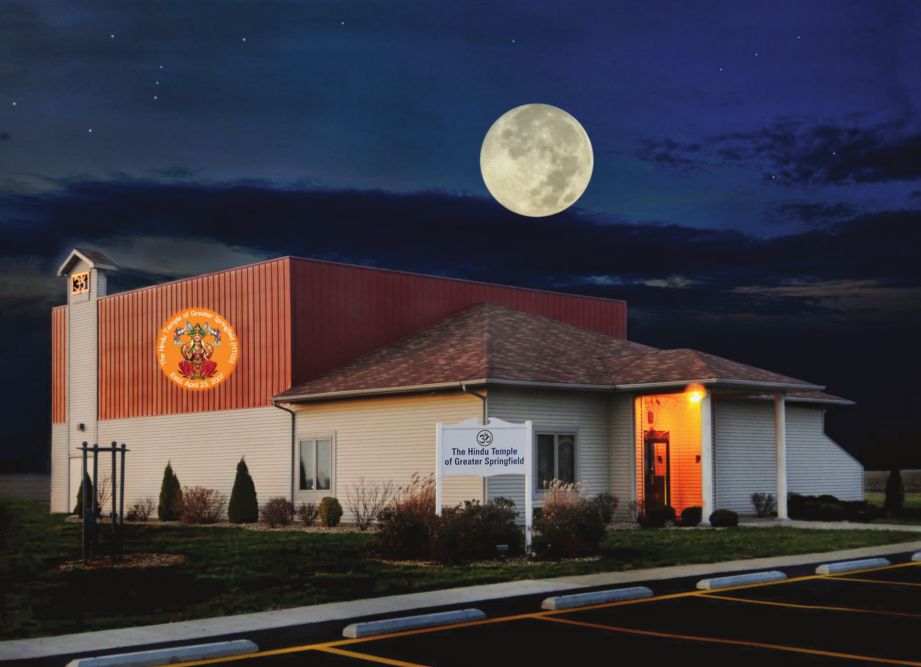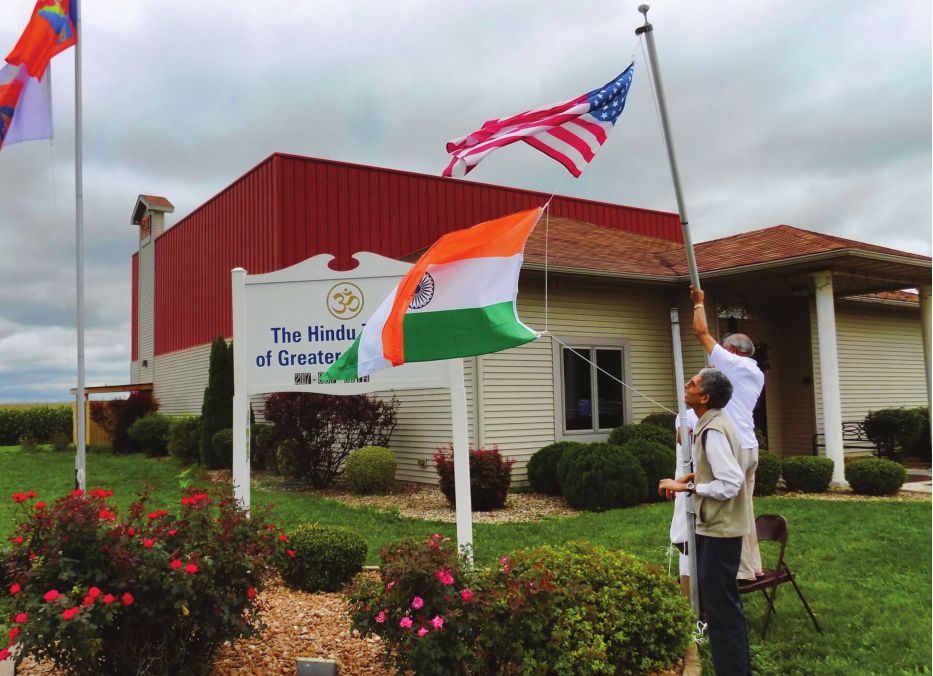
Chatham temple eyes expansion
At sunset one recent Thursday, Dr. Dharmendra Nimavat pauses outside the Hindu Temple of Greater Springfield, where he is installing new flags to replace storm-tattered banners.
New complete-with-fold-marks flags of India and the temple itself are ready, but the U.S. flag is missing. Nimavat, a pediatrician at Southern Illinois University School of Medicine, unlocks the temple and checks inside. Still no luck. An American flag will be here soon, he determines after making a phone call. In the meantime, the flags that are ready are hoisted, with top position, above the Indian flag, left vacant for the expected U.S. flag, which Nimavat explains should naturally fly above the flag of his native land.
“Wherever you stay, that’s your home country,” Nimavat says. “You should respect it.”
Nimavat is a founding member of the temple that is now observing its eighth anniversary, with expansion plans that could eventually bring a 7,000-square-foot building to nine acres of what is now mostly farmland on the western outskirts of Chatham. In conjunction with anniversary observances, the temple has set a goal of raising $250,000 this month toward expansion that could eventually cost more than 10 times that amount.
A temple isn’t necessarily mandatory in Hinduism, often recognized as the world’s oldest religion. Hindus have lived in the Springfield area for decades, long before a temple existed. Home shrines are commonplace.
“In general, Hinduism is not a congregational religion,” says Dr. Krishna Rao, president of the temple’s executive committee and chairman of the strategic planning committee that is creating plans for the new building.
In the Springfield area, desire for a temple that ended up in Chatham grew over the years, fueled by folks like Nimavat, who came to this country in 1996. Worshipping at home, where phone calls and other distractions are near givens, isn’t the same as coming to the temple, he says.
“You don’t get the same vibes when you come to the temple – it’s different,” Nimavat says. “The second generation that’s coming from India, they’re really driving things. They demanded it (a temple), and it’s happened.”
In the early days, before acquiring property, temple members gathered in basements, Nimavat recalls. The need for such gatherings, and for a temple, isn’t just religious. The temple has 90 members, most of Indian heritage (there is also a member from Iran and a member from Nepal). The U.S. Census Bureau doesn’t distinguish between people of Indian descent and other Asians, but it’s fair to say that Indians are a small fraction of the local population.
“The temple is a focal point,” Rao says. “It’s a meeting place to imbibe in our culture so that children in our community get an opportunity to get in touch with our roots. The other factor is, although people can pray at home, deities in temples have been specially energized, imbued with the presence of God. They’ve, in effect, been brought to life by a priest.
“Put another way, air is everywhere. But you go in front of an air conditioner if you want to get cool.”
A temple grows in Chatham The existing temple building was once a Baptist church that closed its doors in 2003. It reopened as the Hindu Temple of Greater Springfield in the summer of 2008, a year after devotees began meeting in private homes and started the search for property.
“Of course, we were all eager to have a temple at some point for religious and cultural purposes,” Rao recalls. “We realized we had a critical mass.”
The Chatham property had several attributes, including plenty of room for expansion. In keeping with principles of Hindu architecture, the lot is rectangular and the structure faces east, although the current premises are nothing fancy.
Since acquiring the building, devotees have paved the parking area, remodeled the kitchen and done some landscaping, but the building itself is barebones, with a metal roof visible from the inside and a worship room decorated with large posters of deities attached to walls made from drywall and metal. The temple adheres to a dress code, with no shoes allowed in the sanctuary and a ban on clothing that exposes shoulders or knees. No alcohol is allowed in the building.
In lieu of theatrical spotlights, devotees use portable work lights typically found at hardware stores during puja, the equivalent of worship ceremonies. Photography is not allowed inside the temple, which fits
neatly into the nearby residential neighborhood to the point that it
could almost be mistaken for a house if not for the parking lot.
“The
current structure, it gets us by,” Rao says. “With the number of
devotees on festival days, it’s too crowded. It doesn’t meet traditional
architectural needs for a new temple.”
The
new building will be at the center of the property where corn and
soybeans are now grown. It will be between 6,000 and 7,000 square feet,
about twice the size of the existing building, Rao said, and will
include a basement. Architectural renderings include a pond and a picnic
area. Devotees are still working on final plans and budgets, but the
initial price tag sits at $2.7 million.
Some
compromises are almost inevitable. In India, Hindu temples tend to be
carved from granite. Granite and granite carvers being scarce in central
Illinois, the temple in Springfield will likely feature plaster, says
Rao, who grew up in Florida, where he says that his father helped
organize and build the first Hindu temple in Tampa. It wasn’t an easy
task, he recalls.
“I initially thought I would not be like my father,” Rao says. “Over time, people change.”
Hinduism
evolved over centuries across India, one of the planet’s most populous
nations. Besides geography, devotees are separated by language, and so
traditions and beliefs vary. In the United States, however, the Indian
population is relatively small, and so organizers must coalesce a temple
community from folks who didn’t necessarily follow the same religious
customs in their homeland. It is, essentially, a theological melting pot
within a cultural melting pot that every immigrant experiences in the
United States.
“It’s fondue all over,” says Dr. Kartik Mani, a cardiovascular physician who is chairman of the temple’s board of trustees.
Diversity
is apparent during temple ceremonies. While groups of a dozen or more
devotees seated on the floor sing or chant together, others walk in,
alone or in twos and threes, to present offerings of fruit or money at
three altars that display statues of more than a dozen deities. Paying
no attention to group rituals, individual devotees clasp hands in prayer
form or prostate themselves in various directions or simply linger for a
few moments at the altar before leaving. Some appear to pray before
pictures of deities that hang from the walls. Some announce their
entrance into the worship room by ringing a bell that hangs at the
entrance, others do not. No two devotees do exactly the same thing.
Almost no one arrives empty-handed.
Rather,
one devotee after another brings fruit, milk, honey, flowers and other
offerings that are placed before or on statues of deities by the priest.
There are also plenty of Tupperware containers filled with food to
share at the conclusion of official proceedings.
“The idea is, God has given us so much, I’m trying to give something back,” Nimavat explains.
The gifts placed before the altar are not to deities so much as to the gift giver, Mani says.
“God
doesn’t need flowers,” Mani says. “He has the whole world. Why does he –
or she – need flowers from me?” A Hindu priest can be called on to
preside over events ranging from weddings to a child’s first haircut.
Even with no devotees present on a recent Saturday morning, Keshava
Shastry, the temple’s priest, chants softly before statues of deities,
occasionally ringing a hand-held bell, while a cleaning woman vacuums
the temple. In silence save for the vacuum cleaner’s whir, Shastry tends
to the altar as if he were a gardener, waving a candle before statues
and discarding offerings of fruit that are past their prime.
During
ceremonies with devotees, Shastry chants from memory mantras in
Sanskrit, sounding not unlike an auctioneer as he goes on for 45 minutes
without pause. He says that it took him more than a decade of training
in India to memorize mantras, some of which are without any meaning but
are still considered important for their rhythmic, peaceful qualities.
He’s been at the temple for 1 ½ years and says that he would like to
stay longer.
“Everything (is) good,” he says. “The people are good, the community is good.”
“It’s
a pretty cool religion” With roots dating to 2000 BC, Hinduism is so
old that no one knows just how old. There is no central text akin to the
Bible or Koran, nor does Hinduism have a founder. While there are
annual festivals, there is no weekly Sabbath. It is, scholars and
believers say, as much a way of life as a theology oft-misunderstood in
the West. There are, at once, hundreds of deities but just one supreme
being – the religion accommodates both monotheistic and polytheistic
schools of thought. Even atheists are welcome.
“Non-believers, it’s allowed – officially allowed,” Nimavat says.
Core
principles include the belief that every living thing has a soul and
that the soul is immortal, perhaps attached to a cat during one lifetime
and a human being during a subsequent life. The goal is to end the
cycle of reincarnation so that the soul exists independent of a physical
body.
“You call it salvation, we call it liberation,” Nimavat says.
While
Hinduism doesn’t have the equivalent of Ten Commandments, Nimavat says
that there are a half-dozen rules: Never lie, don’t be violent, don’t
steal, don’t hurt anyone either physically or emotionally, respect
everyone’s existence and respect the existence of God.
There are, Mani says, no experts when it comes to Hinduism.
“If
you could really understand God, that would be a simple god, wouldn’t
it?” he says, paraphrasing Albert Einstein. “It’s a matter of personal
desire. It’s a pretty cool religion – it’s a religion that lets you come
up with who you want to be. … Whatever the other person is doing,
that’s cool, too.”
There
are Hindu temples in Bloomington, St. Louis and Champaign, but those
cities all have larger Hindu populations than Springfield, Rao said.
Springfield, he figures, might be the city with the smallest Hindu
population in the nation to have a full-fledged temple. A core group of
devotees donated half the cost of the building and land, Rao says, and
the mortgage was paid off years ago.
“We
have no debts – obviously, that makes it a lot easier,” Rao said. “The
challenge in building…is, we are the smallest community. It could take a
number of years. We would like to see it started and completed in a few
years’ time.”
Statues
of deities within the planned temple will be made from granite and
marble and carved in India. Statues can cost as much as $100,000 apiece.
A preliminary budget shows that $940,000 – more than a third of the
expanded temple’s $2.7 million preliminary price tag – will be spent on
17 statues that will be decorated with jewelry and flowers.
The
temple will be built in honor of Lakshmi, the Hindu goddess of wealth
and wife of Vishnu, one of Hinduism’s three major deities. While
depictions of Lakshmi often show her with gold coins, it’s not
necessarily about money, Mani explains. Wealth can also mean being
blessed with good health or a good family, he says. Lakshmi is also
considered the goddess of spiritual wealth.
“When you pray to Lakshmi, you get wealth in many manifestations,” Mani says.
The same principle, he says, applies as the temple eyes expansion.
“The temple is not the building or the land or anything else,” Mani says. “It’s the community itself.”
Contact Bruce Rushton at [email protected].